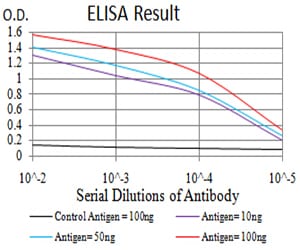

| WB | 咨询技术 | Human,Mouse,Rat |
| IF | 咨询技术 | Human,Mouse,Rat |
| IHC | 咨询技术 | Human,Mouse,Rat |
| ICC | 技术咨询 | Human,Mouse,Rat |
| FCM | 1/200 - 1/400 | Human,Mouse,Rat |
| Elisa | 1/10000 | Human,Mouse,Rat |
| Aliases | BAM32 |
| Entrez GeneID | 27071 |
| clone | 2F7A9 |
| WB Predicted band size | 32.2kDa |
| Host/Isotype | Mouse IgG1 |
| Antibody Type | Primary antibody |
| Storage | Store at 4°C short term. Aliquot and store at -20°C long term. Avoid freeze/thaw cycles. |
| Species Reactivity | Human |
| Immunogen | Purified recombinant fragment of human DAPP1 (AA: 127-276) expressed in E. Coli. |
| Formulation | Purified antibody in PBS with 0.05% sodium azide |
+ +
以下是关于DAPP1抗体的3-4篇参考文献(文献名称、作者及摘要内容概括):
---
1. **文献名称**:*Dual adaptor for phosphotyrosine and 3-phosphoinositides 1 (DAPP1) regulates B cell receptor signaling and immune response*
**作者**:Owen, R., et al.
**摘要**:本研究揭示了DAPP1在B细胞抗原受体(BCR)信号传导中的作用,通过其PH和SH2结构域介导的膜定位与磷酸化酪氨酸相互作用。实验使用DAPP1特异性抗体进行免疫印迹分析,发现DAPP1缺失会导致BCR下游的PI3K-Akt通路活性降低,从而影响B细胞增殖与抗体产生。
---
2. **文献名称**:*DAPP1 modulates T cell activation and inflammatory response through association with adaptor molecules*
**作者**:Dyson, J., et al.
**摘要**:文章利用DAPP1抗体在流式细胞术和免疫共沉淀中验证了DAPP1在T细胞中的表达及其与LAT、SLP-76等信号分子的相互作用。结果表明,DAPP1通过调控T细胞受体(TCR)信号复合物的组装,影响IL-2分泌和自身免疫疾病模型中的炎症反应。
---
3. **文献名称**:*Characterization of DAPP1 phosphorylation dynamics in immune cell signaling*
**作者**:Saveliev, A., et al.
**摘要**:通过DAPP1磷酸化特异性抗体,作者分析了DAPP1在巨噬细胞和树突状细胞中的酪氨酸磷酸化模式。研究显示,LPS和抗原刺激会诱导DAPP1的快速磷酸化,并促进其与Syk激酶的结合,进而调控NF-κB通路的活化。
---
4. **文献名称**:*DAPP1 deficiency alters germinal center formation and humoral immunity*
**作者**:Marshall, A., et al.
**摘要**:使用DAPP1敲除小鼠模型和抗体染色技术,研究发现DAPP1缺失导致生发中心B细胞数量减少,抗体亲和力成熟受损。该文献强调了DAPP1在体液免疫应答中的关键作用,并通过免疫组化验证了DAPP1在淋巴组织中的定位。
---
以上文献均涉及DAPP1抗体的实验应用(如Western blot、免疫沉淀等),并探讨了DAPP1在免疫信号传导中的功能机制。如需具体DOI或发表年份,可进一步补充。
DAPP1 (dual adaptor of phosphotyrosine and 3-phosphoinositides), also known as Bam32. is a signaling adaptor protein involved in regulating immune cell activation, particularly in B lymphocytes. It contains an N-terminal SH2 domain that binds phosphotyrosine residues and a C-terminal PH domain that interacts with phosphatidylinositol (3.4.5)-trisphosphate (PIP3), linking receptor-activated tyrosine kinases to downstream pathways. DAPP1 plays a role in B-cell receptor (BCR) signaling, influencing cell survival, proliferation, and differentiation by modulating Akt, MAPK, and NF-κB pathways. Its expression is predominantly observed in lymphoid tissues.
DAPP1 antibodies are immunological tools designed to detect and study the expression, localization, and function of this protein. They are widely used in research to investigate B-cell development, immune dysregulation, and malignancies like B-cell lymphomas. Polyclonal and monoclonal anti-DAPP1 antibodies are generated using immunogenic peptide sequences from conserved regions of the protein. Validation typically includes Western blotting, immunohistochemistry, and flow cytometry. Dysregulation of DAPP1 has been implicated in autoimmune diseases and cancers, making its study critical for understanding immune signaling networks and therapeutic targeting. These antibodies aid in elucidating mechanisms of immune cell activation and pathological conditions linked to DAPP1 dysfunction.
×